tire pressure MERCEDES-BENZ GL SUV 2012 Owners Manual
[x] Cancel search | Manufacturer: MERCEDES-BENZ, Model Year: 2012, Model line: GL SUV, Model: MERCEDES-BENZ GL SUV 2012Pages: 441, PDF Size: 10.66 MB
Page 24 of 441
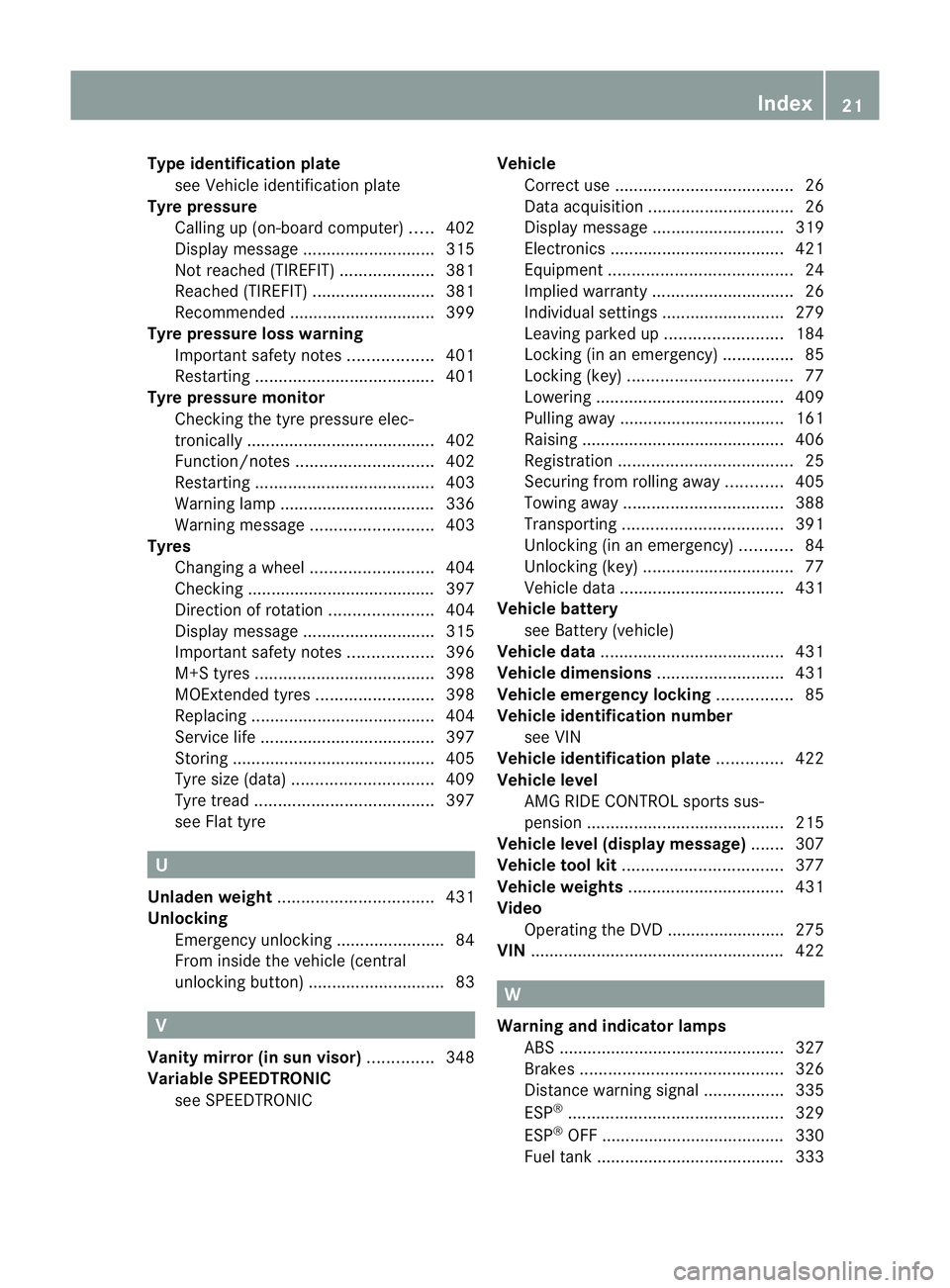
Type identificatio
nplate
see Vehicl eide ntificatio nplate
Tyr epressure
Calling up (on-board computer )..... 402
Display message ............................ 315
Not reac hed( TIREFIT) .................... 381
Reache d(TIREFIT) .......................... 381
Rec ommended ............................... 399
Tyre pressur elossw arning
Important safety notes ..................401
Restarting ...................................... 401
Tyre pressure mon itor
Checking the tyre pressure elec-
tronically ........................................ 402
Function/notes ............................. 402
Restarting ...................................... 403
Warn ingl am p................................. 336
Warning mess age. ......................... 403
Tyres
Changing awheel .......................... 404
Ch ecking ........................................ 397
Directio nofrotation ...................... 404
Display message ............................ 315
Important safety notes ..................396
M+S tyre s...................................... 398
MOExtende dtyres ......................... 398
Replacing ....................................... 404
Service life ..................................... 397
Storing ........................................... 405
Tyr esize (data) .............................. 409
Tyr etrea d...................................... 397
se eF lat tyre U
Unladen weight ................................. 431
Un lock ing
Emergency unlocking .......................84
From insid ethe vehicle (central
unl ocking button) ............................. 83 V
Vanity mirror (in sun visor) ..............348
Variable SP EEDTRONIC
se eS PEEDTRONIC Vehicle
Corr ectu se ...................................... 26
Data acq uisition ............................... 26
Display message ............................ 319
Electronics ..................................... 421
Equ ipment ....................................... 24
Implie dwarranty .............................. 26
Individua lsettings .......................... 279
Leaving pa rkedup. ........................ 184
Locking (i nanemergency) ............... 85
Locking (ke y)................................... 77
Lowering ........................................ 409
Pullin gaway................................... 161
Rais ing. .......................................... 406
Registratio n..................................... 25
Securing from rol ling away ............ 405
To wing away .................................. 388
Transporting .................................. 391
Unlockin g(in an emergency) ...........84
Unlockin g(key )................................ 77
Veh icle data ................................... 431
Vehi cleb attery
se eB attery (vehicle)
Vehicle data ....................................... 431
Vehi cled imensions ........................... 431
Vehi clee mergency locking ................85
Vehi clei dentification number
se eV IN
Vehi clei dentification plate ..............422
Vehi clel evel
AMG RIDE CONTROL sports sus-
pension .......................................... 215
Vehi clel evel (display message) .......307
Vehi clet ool kit .................................. 377
Vehi clew eights ................................. 431
Video Operating the DVD ......................... 275
VIN ...................................................... 422 W
Warning and indicator lamps ABS ................................................ 327
Brake s........................................... 326
Distance warning signa l................. 335
ESP ®
.............................................. 329
ESP ®
OFF ....................................... 330
Fue ltank ........................................ 333 Index
21
Page 382 of 441
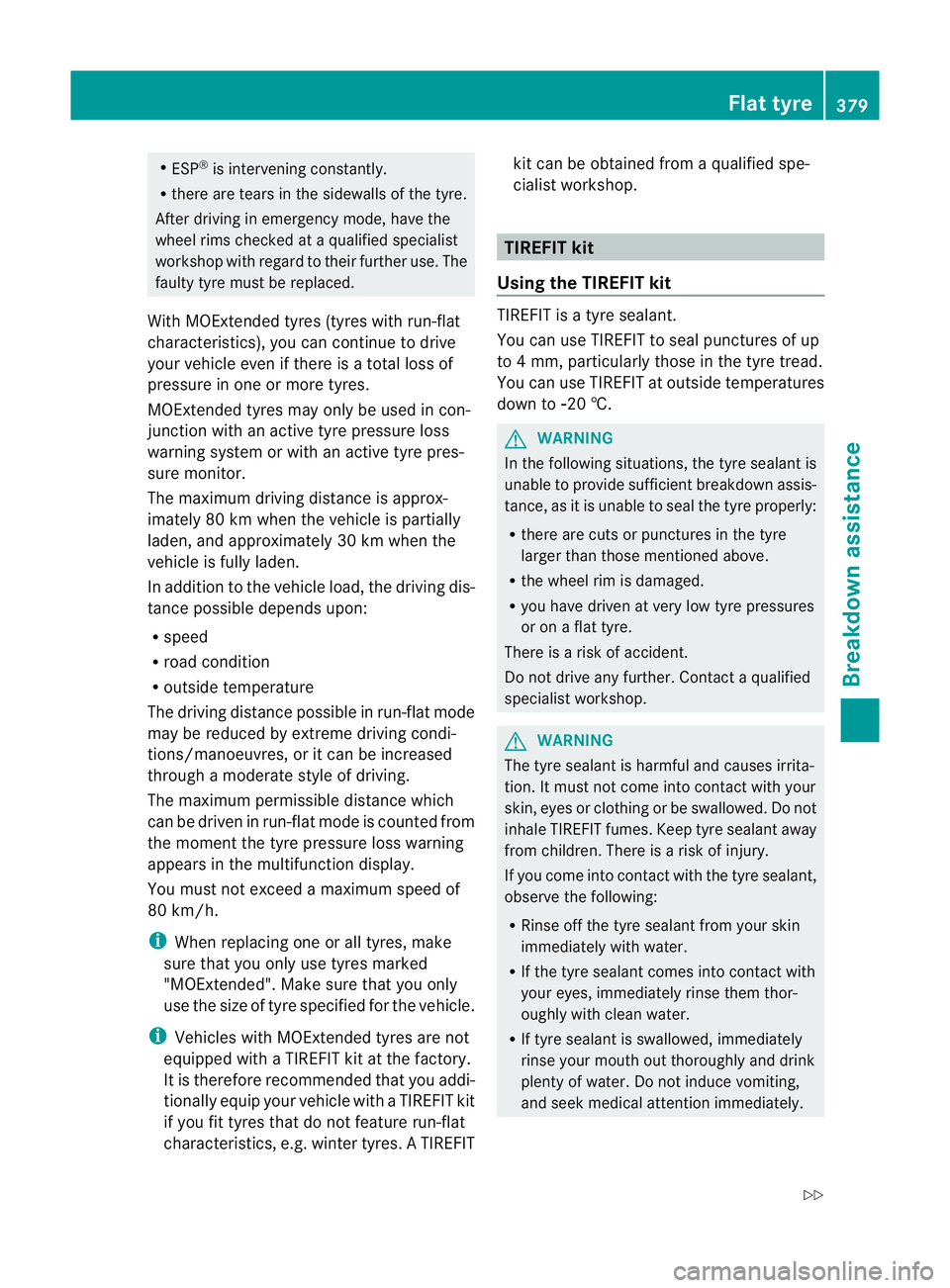
R
ESP ®
is intervening constantly.
R there are tears in the sidewall softhe tyre.
After driving in emergency mode, have the
whee lrims checked at aquali fied specialist
workshop with regar dtotheir furthe ruse. The
fault ytyre must be replaced.
With MOExtended tyres (tyres with run-flat
characteristics), you can continue to drive
your vehicle even if there is atotal loss of
pressure in one or mor etyres.
MOExtended tyres may only be used in con-
junction with an active tyre pressure loss
warning syste morwith an activ etyre pres-
sure monitor.
The maximum driving distance is approx-
imately 80 km when the vehicle is partially
laden, and approximatel y30kmwhen the
vehicle is fully laden.
In addition to the vehicle load, the drivin gdis-
tance possible depends upon:
R speed
R road condition
R outside temperature
The drivin gdistance possible in run-flat mode
may be reduced by extrem edriving condi-
tions/manoeuvres ,oritcan be increased
through amoderate style of driving.
The maximum permissible distance which
can be driven in run-flat mode is counted from
the moment the tyr epressure loss warning
appe arsint he multifunction display.
You must not exceed amaximum spee dof
80 km/h.
i When replacing one or all tyres, make
sure tha tyou only use tyres marked
"MOExtended". Make sure that you only
use the size of tyr especified for the vehicle.
i Vehicles with MOExtended tyres are not
equipped with aTIREFIT kit at th efactory.
It is therefore recommended that you addi-
tionally equip your vehicle with aTIREFIT kit
if yo ufit tyres that do not featur erun-flat
characteristics, e.g. winter tyres. ATIREFIT kit can be obtaine
dfrom aqualified spe-
cialist workshop. TIREFIT kit
Usin gthe TIREFIT kit TIREFIT is
atyre seal ant.
You can use TIREFIT to seal punctures of up
to 4m m, particularl ythose in the tyr etread.
Yo uc an use TIREFI Tatoutside temperatures
down to Ò20 †. G
WARNING
In the following situations, the tyre sealant is
unable to provide sufficient breakdown assis-
tance, as it is unable to seal the tyre properly:
R there are cuts or punctures in the tyre
larger than those mentioned above.
R the wheel rim is damaged.
R you have driven at very low tyre pressures
or on aflat tyre.
There is arisk of accident.
Do not drive any further. Contact aqualified
specialist workshop. G
WARNING
The tyre sealant is harmful and causes irrita-
tion. It must not come into contact with your
skin, eyes or clothing or be swallowed. Do not
inhale TIREFIT fumes. Keep tyre sealant away
from children. There is arisk of injury.
If you come into contact with the tyre sealant,
observe the following:
R Rinse off the tyre sealant from your skin
immediately with water.
R If the tyre sealant comes into contact with
your eyes, immediately rinse them thor-
oughly with clean water.
R If tyre sealant is swallowed, immediately
rinse your mouth out thoroughly and drink
plenty of water. Do not induce vomiting,
and seek medical attention immediately. Flat tyre
379Breakdown assistance
Z
Page 383 of 441
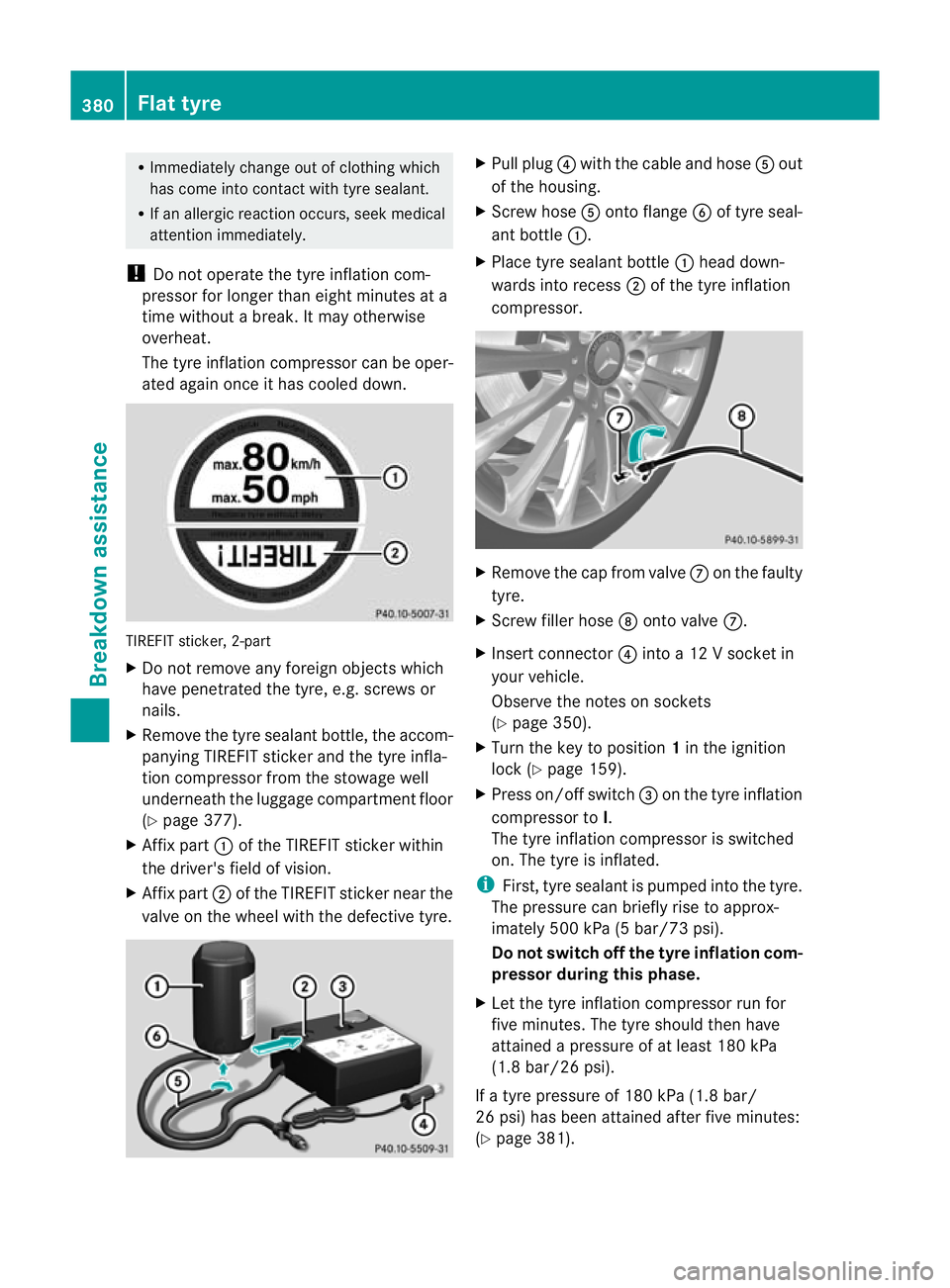
R
Immediately chang eout of clothing which
has come into contact with tyre sealant.
R If an allergic reaction occurs, seek medical
attention immediately.
! Do not operate the tyre inflation com-
pressor for longe rthan eight minutes at a
tim ew ithou tabreak. It may othe rwise
overheat.
The tyre inflation compressor can be oper-
ated again onc eithas cooled down. TIREFIT sticker, 2-part
X
Do not remov eany foreig nobjects which
have penetrated the tyre, e.g. screws or
nails.
X Remov ethe tyr esealan tbottle, the accom-
panying TIREFIT sticker and the tyr einfla-
tion compressor from the stowage well
underneath the luggage compartment floor
(Y pag e377).
X Affix part :of the TIRE FITsticker within
the driver 'sfield of vision.
X Affix part ;of th eTIREFIT sticker near the
valve on th ewheel with the defective tyre. X
Pull plug ?with the cable and hose Aout
of the housing.
X Screw hose Aontoflange Bof tyre seal-
ant bottle :.
X Place tyre sealant bottle :head down-
wards int orecess ;of the tyr einflation
compressor. X
Remove the cap from valve Con the faulty
tyre.
X Screw filler hose Donto valve C.
X Insert connector ?into a12Vs ocket in
your vehicle.
Observ ethe notes on sockets
(Y page 35 0).
X Tur nthe key to position 1in the igni tion
lock (Y page 15 9).
X Press on/off switch =on the tyr einflation
compressor to I.
The tyre inflation compressor is switched
on. The tyre is inflated.
i First, tyre sealant is pumpe dintot he tyre.
The pressur ecan briefly rise to approx-
imately 500 kPa (5 bar/73 psi).
Do not switch off the tyr einfla tion com-
pressor during this phase.
X Let the tyre inflation compresso rrun for
five minutes. The tyre should then have
attained apressure of at leas t180 kPa
(1.8 bar/26 psi).
If at yre pressure of 180 kPa (1.8 bar/
26 psi) has been attained after five minutes:
(Y page 381). 380
Flat tyreBreakdown assistance
Page 384 of 441
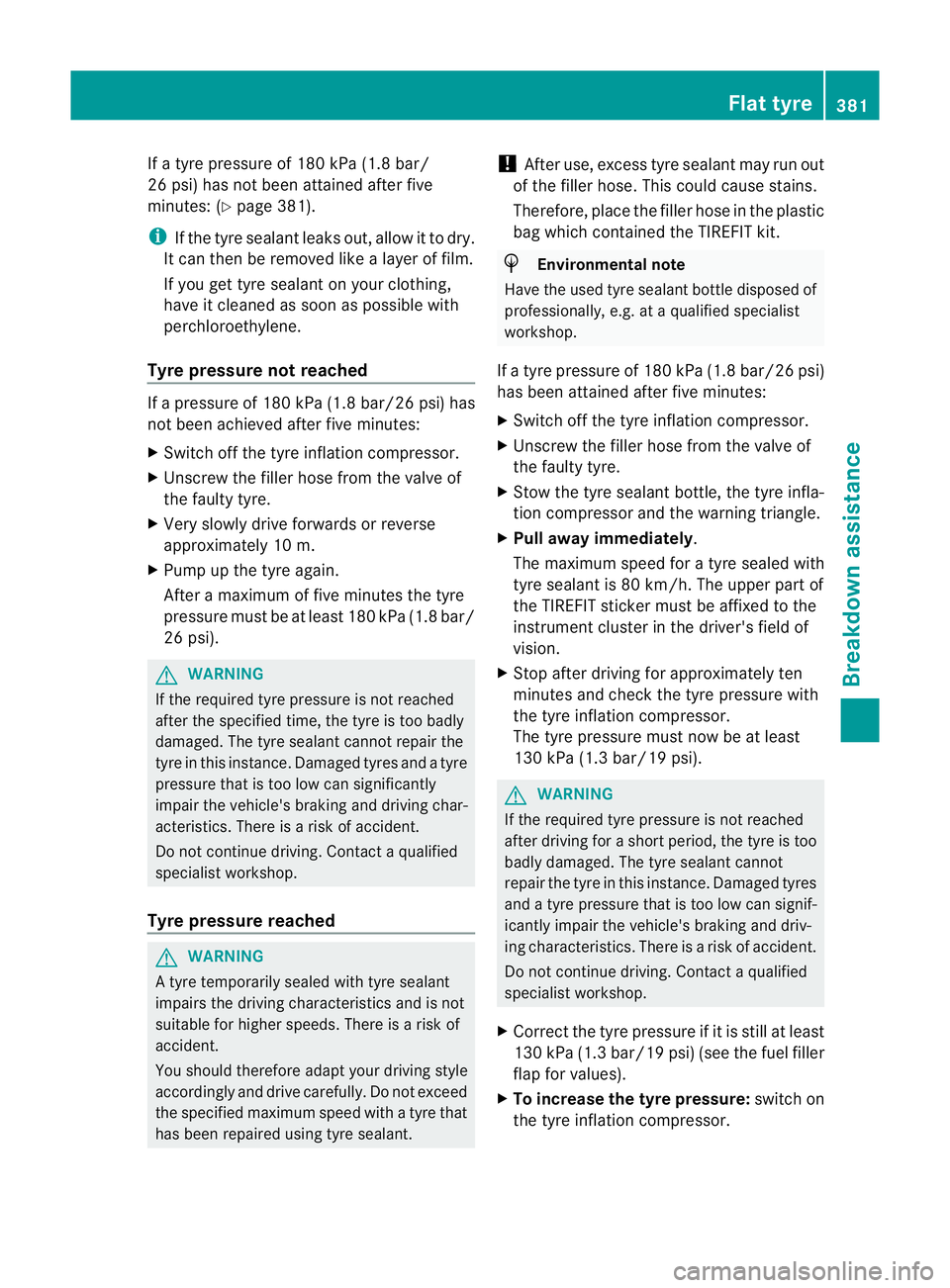
If
at yre press ureof1 80 kPa (1.8 bar/
26 psi) ha snot been attaine dafter five
minutes :(Ypage 381).
i If the tyr esealant leaks out, allow it to dry.
It can then be removed like alayer of film.
If you get tyre sealant on you rclothing,
have it cleaned as soon as possible with
perchloroethylene.
Tyre pressur enot reached If
ap ressure of 180 kPa (1.8 ba r/26 ps i)has
not been achieved after five minutes:
X Switc hoff th etyre inflation compressor.
X Unscrew the filler hos efrom the valve of
the faulty tyre.
X Very slowly drive forwards or reverse
approximatel y10m.
X Pum pupt he tyreagain.
Af teram aximum of five minutes the tyre
pressure must be at least 180 kPa (1.8 bar/
26 psi). G
WARNING
If the required tyre pressure is not reached
after the specified time, the tyre is too badly
damaged. The tyre sealant cannot repair the
tyre in this instance. Damaged tyres and atyre
pressure that is too low can significantly
impair the vehicle's braking and driving char-
acteristics. There is arisk of accident.
Do not continue driving. Contact aqualified
specialist workshop.
Tyr epressure reached G
WARNING
At yre temporarily sealed with tyr esealant
impairs th edrivin gcharacteristic sand is not
suitable for higher speeds. There is arisk of
accident.
You should therefor eadapt your driving style
accordingly and driv ecarefully. Do not exceed
the specified maximum spee dwithatyre that
has been repaired using tyre sealant. !
After use, excess tyre seal antm ay run out
of the filler hose. This could cause stains.
Therefore, place the filler hos einthe plastic
bag whic hcontaine dthe TIREFIT kit. H
Environmenta
lnote
Have the used tyre sealant bottle disposed of
professionally, e.g. at aqualified specialist
workshop.
If at yrep ressure of 18 0kPa (1. 8bar/2 6psi)
has been attained after five minutes:
X Switc hoff th etyre inflation compressor.
X Unscrew the filler hos efrom th evalve of
the faulty tyre.
X Stow the tyre sealant bottle, the tyre infla-
tion compressor and the warning triangle.
X Pull away immediately.
The maximum spee dfor atyre sealed with
tyre sealant is 80 km/h. The upper part of
the TIREFI Tsticker must be affixed to the
instrument cluster in the driver's field of
vision.
X Stop after driving for approximately ten
minutes and check the tyre pressure with
the tyre inflation compressor.
The tyre pressure must now be at least
130 kPa (1.3 bar/19 psi). G
WARNING
If the required tyre pressure is not reached
after driving for ashort period, the tyr eistoo
badly damaged. The tyr esealant can not
re pair the tyr einthis instance. Damaged tyres
and atyre pressure that is too low can signif-
icantly impair the vehicle's braking and driv-
ing characteristics. There is arisk of accident.
Do not continue driving. Contact aqualified
specialist workshop.
X Correct the tyre pressure if it is still at least
130 kPa (1.3 bar/19 psi) (see the fuel filler
flap for values).
X To increase the tyre pressure: switch on
the tyre inflation compressor. Flat tyre
381Breakdown assistance Z
Page 400 of 441
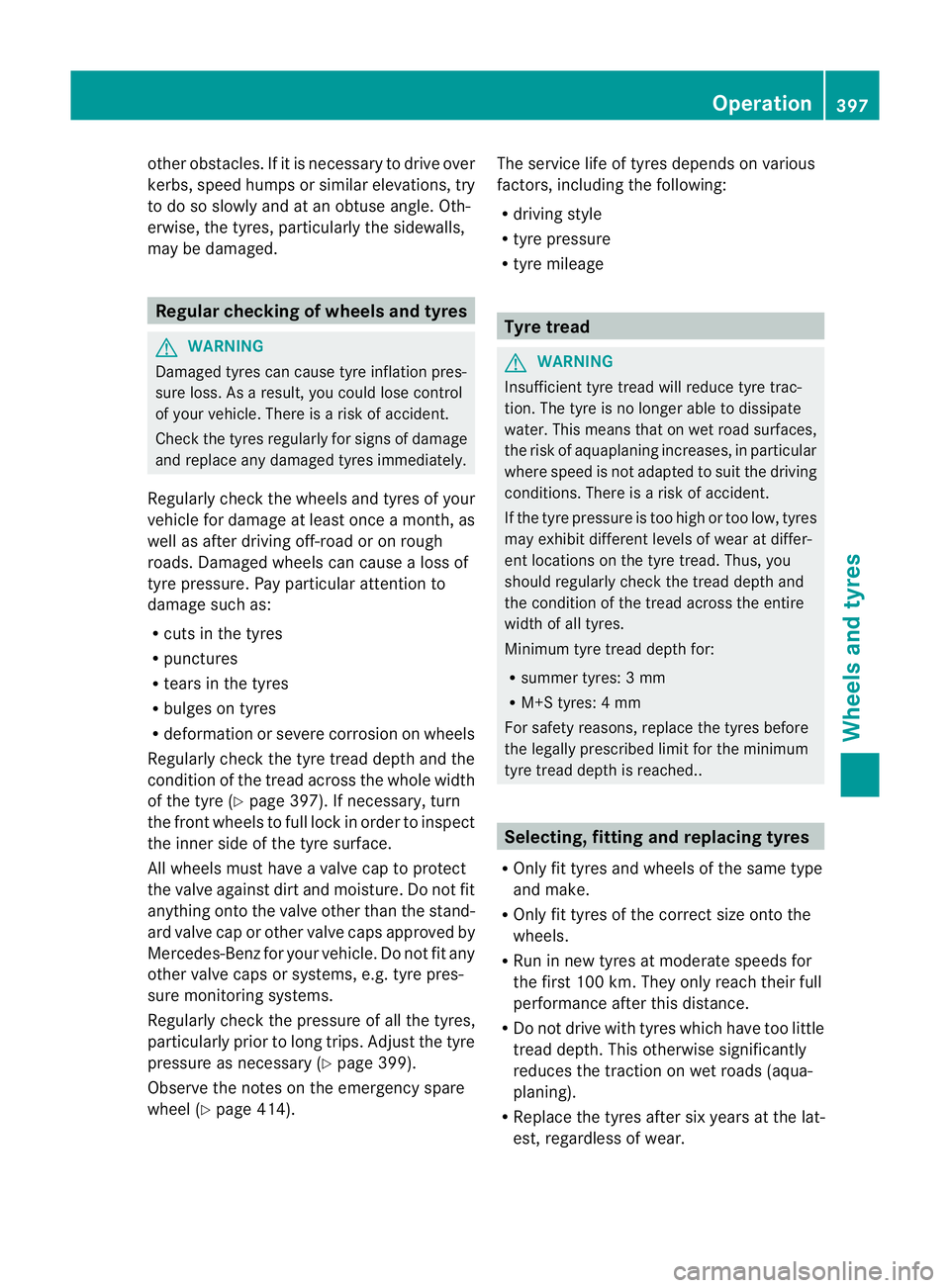
other obstacles. If it is necessary to drive over
kerbs, speed humps or similar elevations, try
to do so slowly and at an obtuse angle .Oth-
erwise ,the tyres, particularly the sidewalls,
ma ybed amaged. Regular checking of wheels and tyres
G
WARNING
Damaged tyres can cause tyre inflation pres-
sure loss .Asaresult,you coul dlose control
of your vehicle. There is arisk of accident.
Check the tyres regularly for signs of damage
and replace any damaged tyres immediately.
Regularly check the wheels and tyres of your
vehicle for damage at least once amonth, as
well as after drivin goff-road or on rough
roads .Damaged wheels can cause aloss of
tyr ep ressure. Pa yparticular attention to
damage such as:
R cuts in the tyres
R punctures
R tears in the tyres
R bulges on tyres
R deformation or severe corrosion on wheels
Regularly check the tyre tread depth and the
condition of the tread across the whole width
of the tyre (Y page 397). If necessary, turn
the front wheelst ofull lock in order to inspect
the inner side of the tyre surface.
All wheel smust have avalve cap to protect
the valve against dirt and moisture. Do not fit
anything onto the valve other than the stand-
ard valve cap or other valve caps approved by
Mercedes-Benz for your vehicle. Do not fit any
other valve caps or systems, e.g. tyre pres-
sure monitoring systems.
Regularly check the pressure of all the tyres,
particularly prior to long trips. Adjust the tyre
pressure as necessary (Y page 399).
Observe the notes on the emergenc yspare
wheel (Y page 414). The service life of tyres depends on various
factors, including the following:
R
driving style
R tyr ep ressure
R tyre mileage Tyre tread
G
WARNING
Insufficient tyre trea dwill reduce tyre trac-
tion. The tyre is no longer able to dissipate
water. This means that on wet road surfaces,
the risk of aquaplaning increases, in particular
where speed is not adapted to suit the driving
conditions. There is arisk of accident.
If the tyre pressure is too high or too low, tyres
may exhibit different levels of wear at differ-
ent locations on the tyre tread. Thus, you
should regularly check the tread depth and
the condition of the tread across the entire
width of all tyres.
Minimum tyre tread depth for:
R summer tyres: 3mm
R M+S tyres: 4mm
For safety reasons ,replace the tyres before
the legally prescribed limi tfor the minimum
tyr etrea ddepth is reached.. Selecting, fitting and replacing ty
res
R Only fi ttyres and wheels of the same type
and make.
R Only fit tyres of the correc tsize ont othe
wheels.
R Run in new tyres at moderate speeds for
the first 10 0km. They onl yreach their full
performanc eafter this distance.
R Do not drive wit htyres which have too little
tread depth .This otherwise significantly
reduce sthe traction on wet roads (aqua-
planing).
R Replace the tyres after six year satthe lat-
est, regardless of wear. Operation
397Wheels and ty res Z
Page 401 of 441
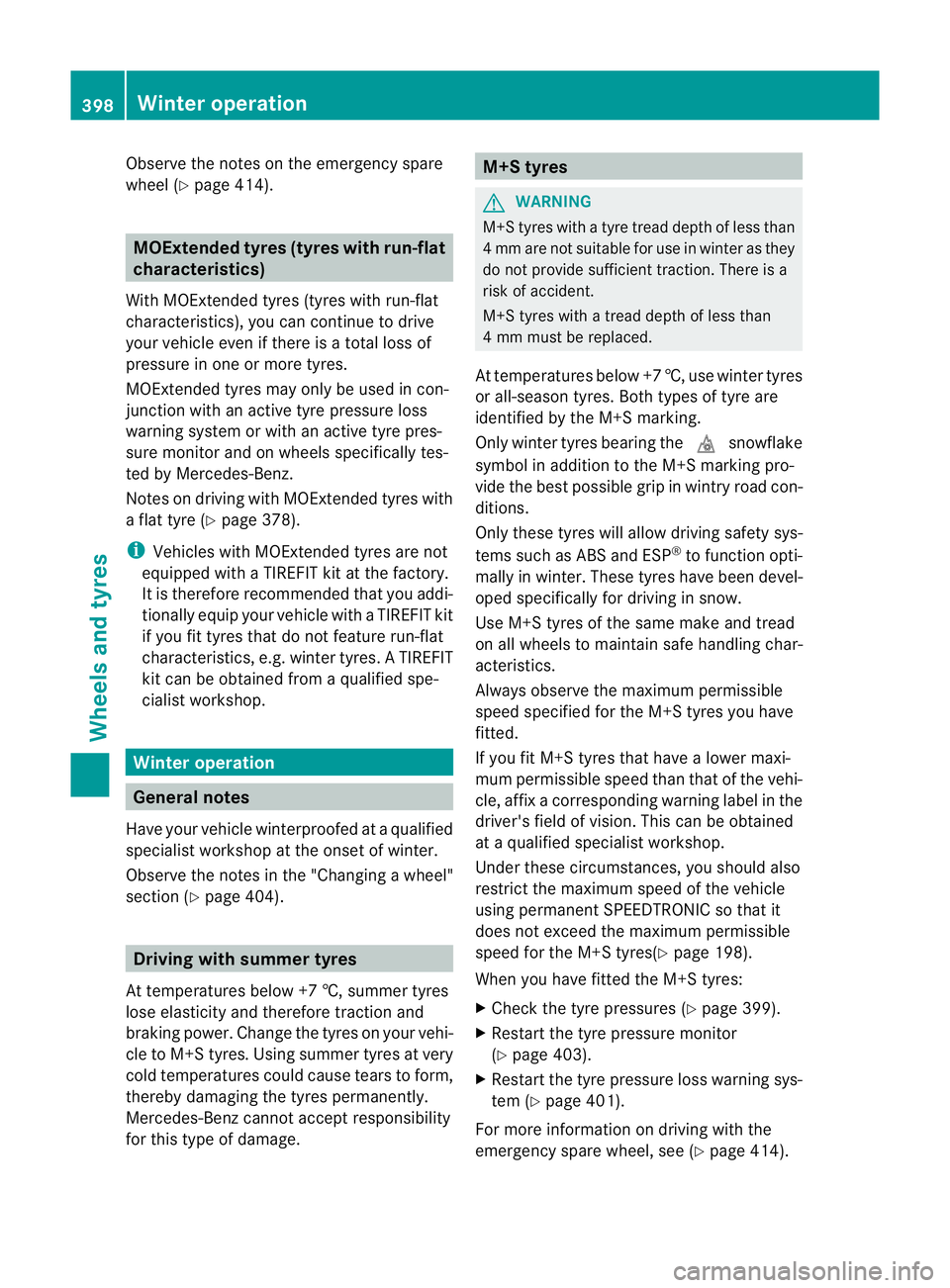
Observe the notes on the emergenc
yspare
wheel (Y page 414). MOExtended tyres (tyres with run-flat
characteristics)
With MOExtended tyres (tyres with run-flat
characteristics), you can continue to drive
your vehicle even if there is atotal loss of
pressure in one or mor etyres.
MOExtended tyres may only be used in con-
junction with an active tyre pressure loss
warning syste morwith an activ etyre pres-
sure monitor and on wheels specificall ytes-
ted by Mercedes-Ben z.
No tes on driving with MOExtended tyres with
af lat tyre (Y page 378).
i Vehicles with MOExtended tyres are not
equipped with aTIREFIT kit at th efactory.
It is therefore recommended that you addi-
tionally equi pyour vehicle with aTIREFIT kit
if yo ufit tyres that do not featur erun-flat
characteristics, e.g. winter tyres. ATIREFIT
kit can be obtaine dfrom aqualified spe-
cialist workshop. Winter operation
General notes
Have your vehicle winterproofed at aqualified
specialist worksho patthe onset of winter.
Observ ethe notes in the "Changin gawheel"
section (Y page 404). Driving wit
hsummer tyres
At temperatures belo w+7† ,summer tyres
lose elasticity and therefore traction and
braking power. Change the tyres on your vehi-
cle to M+S tyres .Using summer tyres at very
cold temperatures could cause tears to form,
thereby damaging the tyres permanently.
Mercedes-Benz cannot accept responsibility
for this typ eofdamage. M+S tyres
G
WARNING
M+S tyres with atyre tread depth of less than
4mma re not su itable for use in winter as they
do not provid esufficient traction. There is a
risk of accident.
M+S tyres with atrea ddepth of less than
4mmm ust be replaced.
At temperatures below +7 †, use winter tyres
or all-seas ontyres.B oth types of tyr eare
identified by th eM+S marking.
Onl ywinter tyres bearing the isnowflake
symbol in addition to the M+S marking pro-
vide the best possible grip in wintr yroad con-
ditions.
Only these tyres will allow drivin gsafety sys-
tems such as ABS and ESP ®
to function opti-
mally in winter. Thes etyres have been devel-
ope dspecifically for driving in snow.
Use M+S tyres of the same mak eand tread
on all wheels to maintain safe handling char-
acteris tics.
Alway sobserv ethe maximum permissible
speed specifie dfor the M+S tyres you have
fit ted.
If you fit M+S tyres that have alower maxi-
mu mp ermissible speed than that of the vehi-
cle, affix acorresponding warnin glabel in the
driver' sfield of vision. This can be obtained
at aq ualified specialist workshop.
Under these circumstances, you should also
restrict the maximum spee dofthe vehicle
usin gpermanen tSPEEDTRONIC so that it
does not exceed the maximu mpermissible
speed for the M+S tyres(Y page 198).
When you have fit tedt he M+S tyres:
X Chec kthe tyr epressures (Y page 399).
X Restart th etyre pressure monitor
(Y page 403).
X Restart the tyre pressure los swarning sys-
tem (Y page 401).
For more information on driving with the
emergenc yspare wheel, see (Y page 414).398
Winter opera
tionWheels and tyres
Page 412 of 441
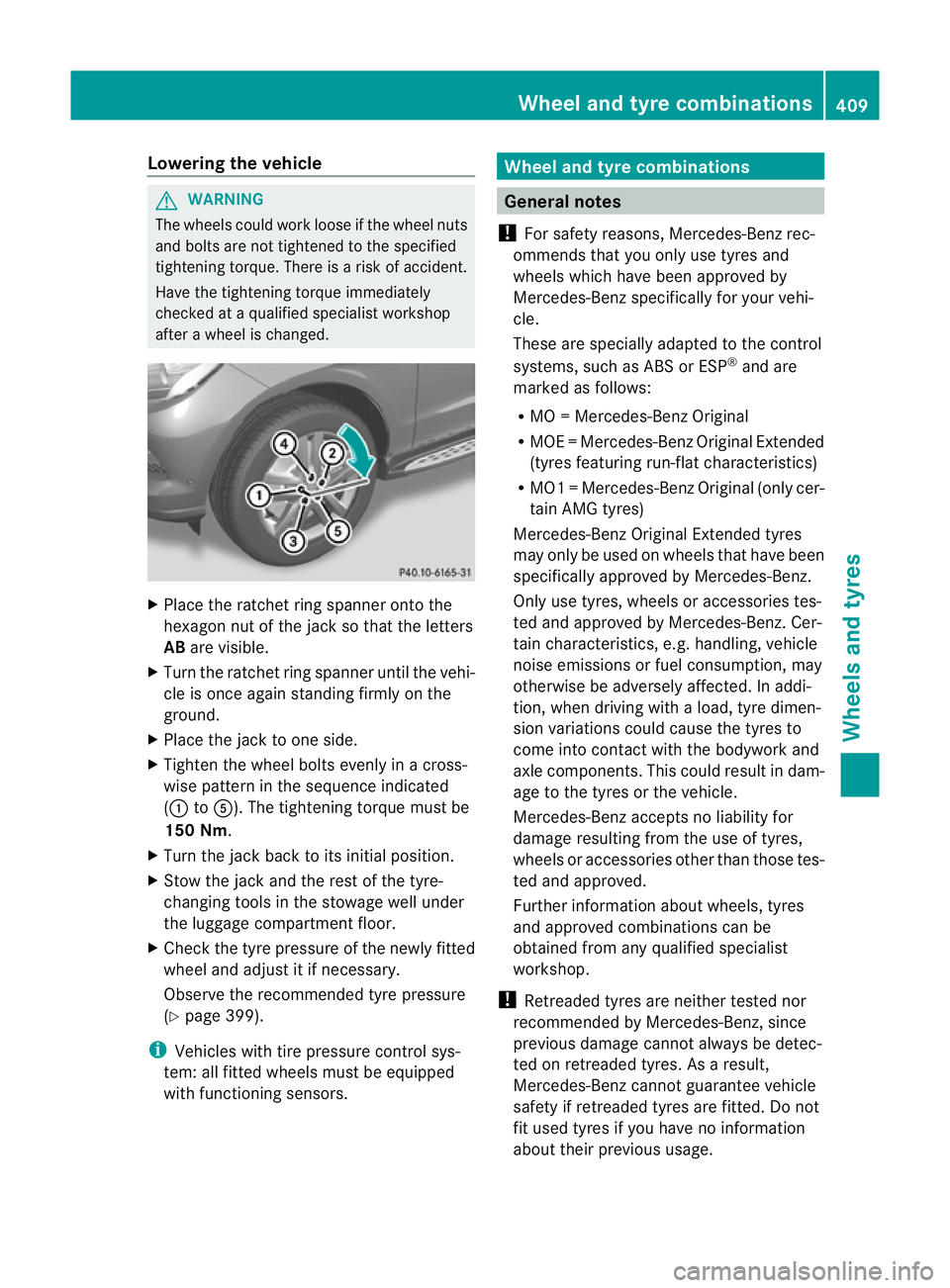
Lowering th
evehicle G
WARNING
The wheels could work loose if th ewheel nuts
and bolt sare not tightened to the specified
tightening torque. There is arisk of accident.
Have the tightening torque immediately
checked at aqualified specialist workshop
after awheel is changed. X
Plac ethe ratchet ring spanner ont othe
hexagon nut of the jac ksothat the letters
AB arev isible.
X Turn the ratchet ring spanner until the vehi-
cle is once again standing firmly on the
ground.
X Place the jack to one side.
X Tighten the wheel bolts evenly in across-
wis epattern in the sequence indicated
(: toA). The tightening torque must be
150 Nm.
X Turn the jack back to its initial position.
X Stow the jack and the rest of the tyre-
changing tools in the stowage well under
the luggag ecompart ment floor.
X Check the tyre pressure of the newly fitted
wheel and adjus titifnecessary.
Observ ethe recommended tyr epressure
(Y page 399).
i Vehicles wit htire pressure control sys-
tem: all fitted wheels must be equipped
with func tionin gsensors. Wheel and ty
recombinations General notes
! For safety reasons, Mercedes-Benz rec-
ommends that you only use tyres and
wheels which have been approved by
Mercedes-Benz specifically for your vehi-
cle.
Thes eare speciall yadapted to the control
systems, such as ABS or ESP ®
and are
marked as follows:
R MO =Mercedes-Ben zOriginal
R MOE =Mercedes-Ben zOriginal Extended
(tyres featuring run-flat characteristics)
R MO1 =Mercedes-Ben zOriginal (only cer-
tain AMG tyres)
Mercedes-Benz Original Extended tyres
may only be use donwheels that hav ebeen
specifically approved by Mercedes-Benz.
Only use tyres, wheels or accessories tes-
ted and approved by Mercedes-Benz. Cer-
tain characteristics, e.g. handling, vehic le
nois eemis sions or fuel consumption, may
otherwise be adv ersely affected. In addi-
tion, when driving with aload, tyr edimen-
sion variations could cause the tyres to
come into contact with the bodywork and
axle components .This could result in dam-
age to the tyres or the vehicle.
Mercedes-Ben zaccept snoliability for
damag eresulting from the use of tyr es,
wheel soraccess orieso the rthan those tes-
ted and approved.
Further information about wheels, tyres
and approved combination scan be
obtained from any qualified specialist
workshop.
! Retreaded tyres are neither tested nor
recommended by Mercedes-Benz, since
previous damage cannot always be detec-
ted on retreaded tyres. As aresult,
Mercedes-Ben zcannot guarantee vehicle
safet yifretreade dtyres are fitted. Do not
fit used tyres if you have no information
about their previous usage. Wheel and tyre combinations
409Wheelsand tyres Z
Page 413 of 441
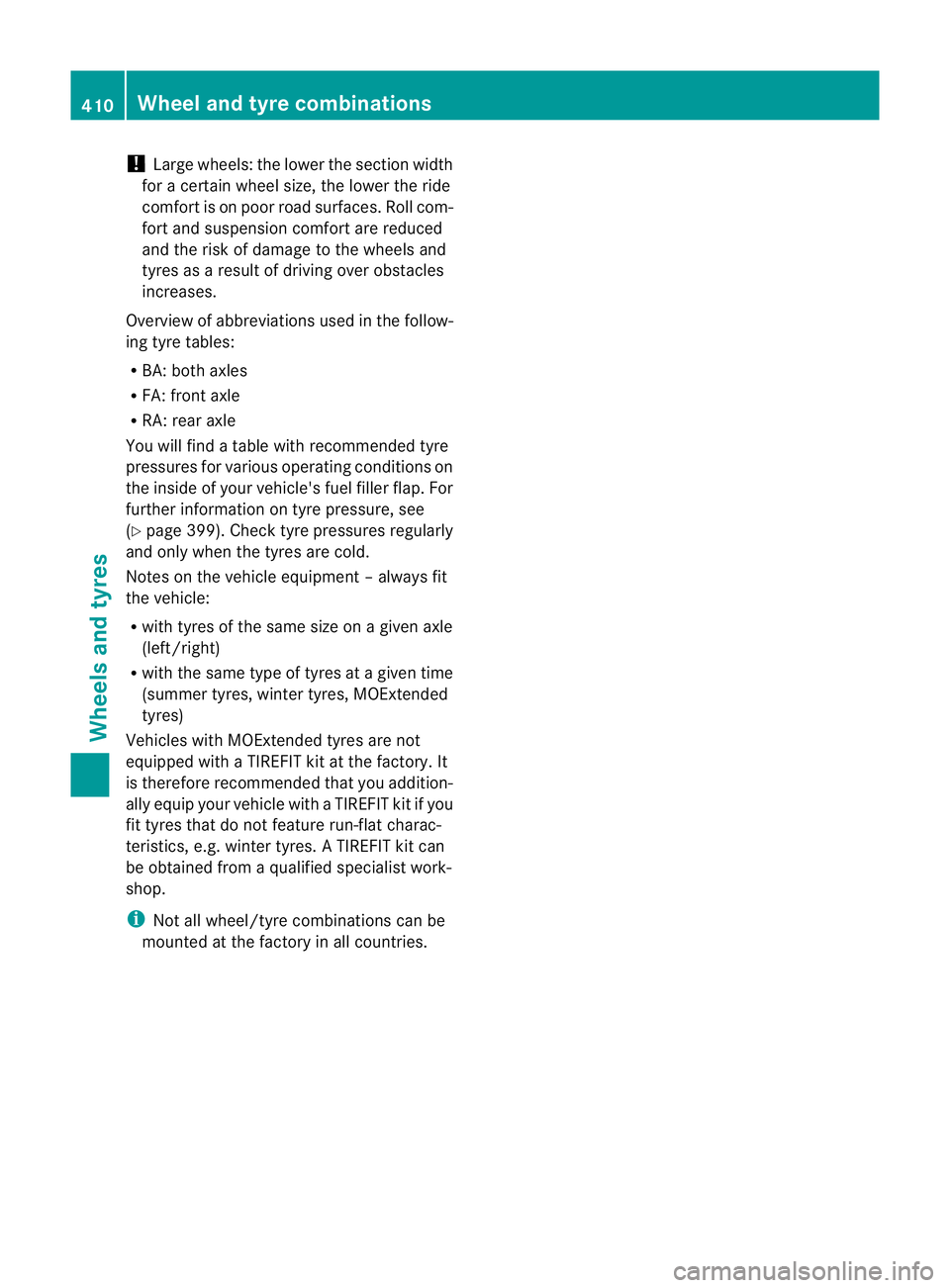
!
Larg ewheels: the lower the section width
for acertain wheel size, the lower the ride
comfor tiso np oor roa dsurfaces. Roll com-
fort and suspensio ncomfort ar ereduced
and the risk of damage to the wheels and
tyres as aresult of driving over obstacles
increases.
Overview of abbreviations used in the follow-
ing tyr etables:
R BA: both axles
R FA: front axle
R RA: rear axle
You will find atable with recommended tyre
pressures for various operating conditions on
the inside of your vehicle's fuel filler flap. For
further information on tyre pressure, see
(Y page 399). Check tyre pressures regularly
and only when the tyres are cold.
Notes on the vehicle equipment –always fit
the vehicle:
R with tyre softhe sam esize on agiven axle
(left/right)
R with the same type of tyre satagiven time
(summer tyres, winter tyres, MOEx tended
tyres)
Vehicles with MO Extended tyres are not
equippe dwithaTIREFIT kit at th efactory. It
is therefore recommended that you addition-
ally equip your vehicle with aTIREFIT kit if you
fit tyres that do no tfeature run -flat charac-
teristics, e.g. winter tyres. ATIREFIT kit can
be obtaine dfrom aqualified specialist work-
shop.
i Not all wheel/tyre combinations can be
mounted at the factory in all countries. 410
Wheel and tyr
ecombinationsWheels and tyres
Page 428 of 441
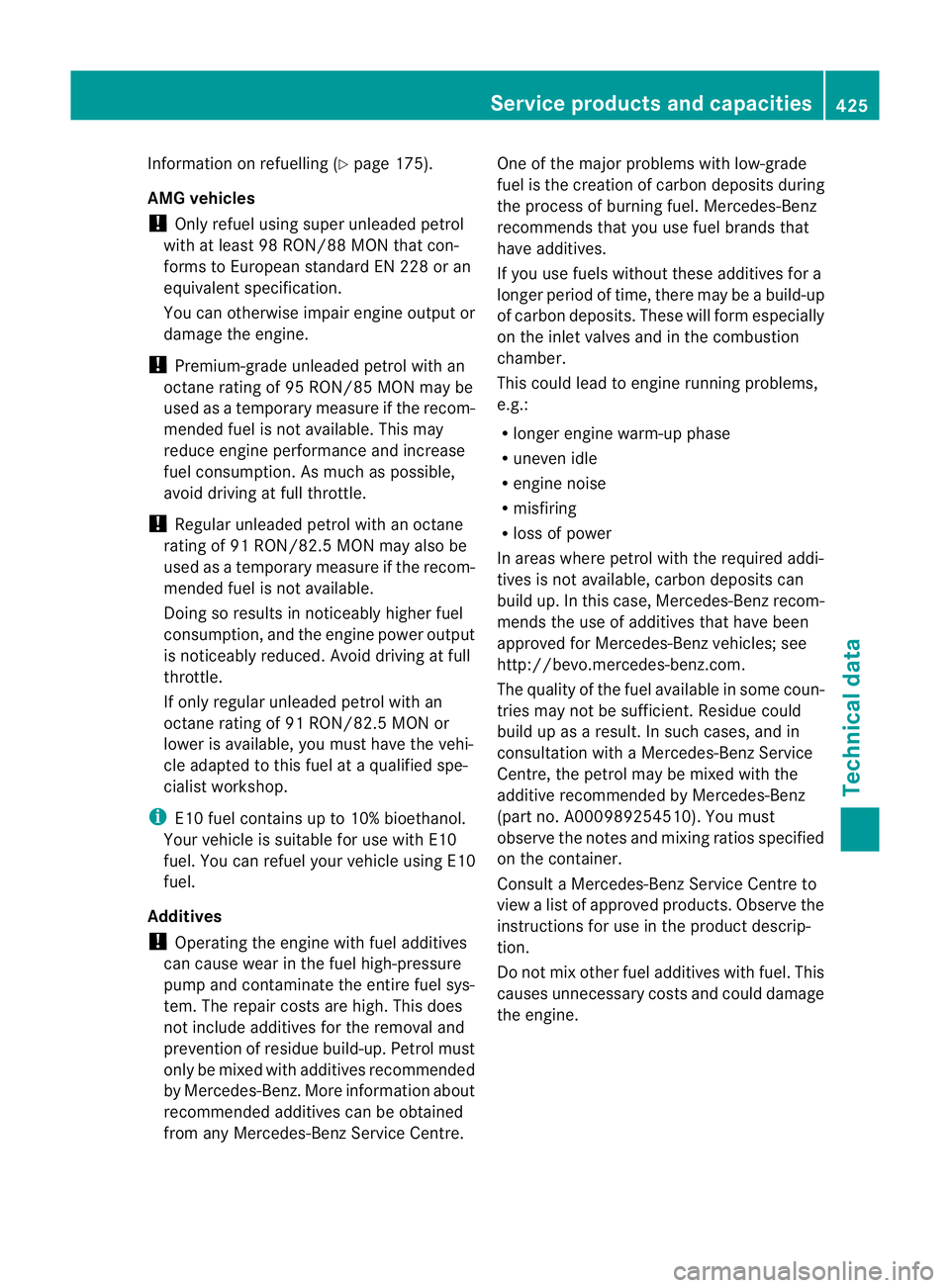
Information on refuelling (Y
page 175).
AMG vehicles
! Only refuel using supe runleaded petrol
with at leas t98RON/88 MO Nthat con-
forms to Europea nstandard EN 228 or an
equival ents pecif ication.
Yo uc an otherwise impai rengine outpu tor
damage the engine.
! Premium-grade unleaded petro lwith an
octane ratin gof95R ON/85 MON ma ybe
used as atemporar ymeasur eifthe recom-
mended fuel is not available. This may
reduce engin eperforman ceand increase
fuel consumption .Asmuch as possible,
avoid driving at full throttle.
! Regular unleade dpetrol with an octane
rating of 91 RON/82.5 MON may also be
used as atemporary measure if the recom-
mended fuel is not available.
Doing so result sinnoticeably higher fuel
consumption ,and the engine power output
is noticeably reduced .Avoi dd riving at full
throt tle.
If only regular unleaded petrol with an
octane ratingof91R ON/82.5 MO Nor
lowe risa vailable ,you must have the vehi-
cle adapted to this fuel at aqualified spe-
cialist workshop.
i E10 fuel contains up to 10% bioethanol.
Your vehicle is suitabl efor use with E10
fuel. You can refuel your vehicle using E10
fuel.
Additives
! Operatin gthe engin ewith fuel additives
can cause wear in the fuel high-pressure
pump and contaminate the entire fuel sys-
tem. The repair costs are high. This does
not include additives for the removal and
prevention of residue build-up. Petrol must
only be mixed with additives recommended
by Mercedes-Benz .More information about
recommended additives can be obtained
from any Mercedes-Benz Servic eCentre. One of the major problem
swith low-grade
fuel is the creation of carbon deposits during
the process of burnin gfuel. Mercedes-Benz
recommends that you use fuel brands that
have additives.
If you use fuels without these additives for a
longer period of time, there may be abuild-up
of carbon deposits. Thes ewill form especially
on the inlet valves and in the combustion
chamber.
This could lead to engine runnin gproblems,
e.g.:
R longe rengine warm-up phase
R uneven idle
R engine noise
R misfiring
R los so fpower
In areas where petrol with the required addi-
tives is not available, carbon deposits can
build up. In this case, Mercedes-Benz recom-
mends the use of additives that have been
approved for Mercedes-Benz vehicles; see
http:/ /bevo.mer cedes-benz.com.
The quality of the fuel available in some coun-
tries may not be sufficien t.Residue could
build up as aresult. In such cases, and in
consultation with aMercedes-Ben zService
Cent re,the petrol ma ybemixed with the
additive recommended by Mercedes-Benz
(part no. A000989254510). You must
observe the notes and mixin gratios specified
on the container.
Consult aMercedes-Ben zService Cent reto
view alist of approved products. Observe the
instruc tions for use in the product descrip-
tion.
Do not mix other fuel additives with fuel. This
causes unnecessary cost sand could damage
the engi ne. Service products and capacities
425Technicaldata Z